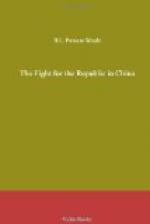The explanation of this extraordinary business was only made public months later with the outbreak of the Yunnan rebellion and the secession of the Southern provinces. In a remarkable publication, entitled satirically “The People’s Will,” the Southern Republican Party, which now possessed access to all the confidential archives of the provinces, published in full the secret instructions from Peking which had brought about this elaborate comedy. Though considerations of space prevent all documents being included in our analysis, the salient ones are here textually quoted so as to exhibit in its proper historical light the character of the chief actor, and the regime the Powers had supported—until they were forced by Japan to be more honest. These documents, consisting mainly of telegraphic dispatches sent from Peking to the provinces, do more to explain the working of the Government of China than a dozen treatises; for they drag into the garish light of day the most secret Yamen machinery and show precisely how it is worked.
The play was set in motion by a circular code telegram sent out on the 30th August by Tuan Chih-kuei, Governor of Moukden and one of Yuan Shih-kai’s most trusted lieutenants, the device of utilizing a centre other than the capital to propagate revolutionary ideas being a familiar one and looked upon as a very discreet procedure. This initial telegram is a document that speaks for itself:
CODE TELEGRAM DATED AUGUST
30, 1915, FROM TUAN CHI-KUEI, MILITARY
GOVERNOR OF MOUKDEN, ET ALIA,
CONTAINING INSTRUCTIONS FOR PRESENTING
PETITIONS TO PEKING IN THE
NAME OF THE CITIZENS OF THE PROVINCES
To the Military and Civil Governors of the Provinces:—
(To be deciphered personally with the Council of State Code)
The proposal of changing the form of the State into a monarchy having been unanimously agreed to by the provinces, the first step to be taken has now to be decided. We propose that petitions be sent in the name of the citizens of the respective provinces to the Senate acting in the capacity of Legislative Chamber, so as to demonstrate the wish of the people to have a monarchy. The




